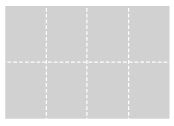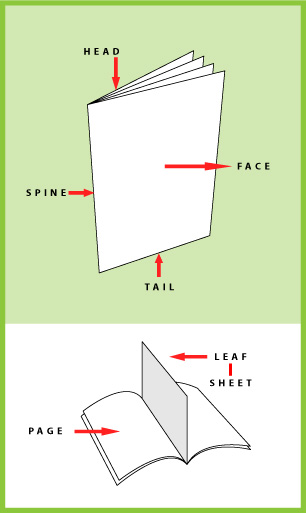Binding Methods
What is Scoring?
Scoring is critical to any binding job. Ask tosee a scoring sample before your job is finished to ensure you get a clean and accurate fold. The score should run in the same direction as the grain of the paper. If the design format requires folding in both directions, the primary fold should be parallel to the grain. Test the sample score by gently folding thepaper; a good score will not crack or tear onthe outside edges. If the paper does crack,the score may need to be wider and deeper. Some scoring problems are caused by improper moisture content in the paper; paper should remain covered when not in use to avoid drying out. If the paper has been exposed, it might help to run the paper through an offset press with a fountain solution to help remoisten the stock. Check with your printer. Finally, be sure the embossed ridge that results from the score is on the inside of the fold [see figures 5 and 6].
What is Signature?
A finished book may appear as if it is made from a stack of loose pages. In many cases,multiple pages are often printed together on a much larger sheet, then folded, collated and trimmed on all sides. The trim eliminates the folds and leaves smooth edges. This is called creating signatures for binding.
A signature is a sheet of printed pages which, when folded, fall in order and become part of a book. Books may be made from more than one signature. Before a signature is created, prepress, in cooperation with bindery, must decide how to lay out the press sheet so the pages will appear in the proper sequence after the press sheets are folded and bound. This is called an imposition.
Flat sheet showing page imposition
 This flat sheet will result in a 16-page book[eight pages on the visible side and eight pages on the back]. Booklets and brochures of 8, 12, 16 or 32 pages may be made from a single folded press sheet depending on the size of the finished piece and the size of the paper. Imposition is the arrangement of pages on the sheet. Proper imposition guarantees that the pages will appear in the proper sequence and position after the sheet is folded and/or trimmed and bound.
This flat sheet will result in a 16-page book[eight pages on the visible side and eight pages on the back]. Booklets and brochures of 8, 12, 16 or 32 pages may be made from a single folded press sheet depending on the size of the finished piece and the size of the paper. Imposition is the arrangement of pages on the sheet. Proper imposition guarantees that the pages will appear in the proper sequence and position after the sheet is folded and/or trimmed and bound.
When a press sheet is folded down, the inside pages will push out further from the spine than the outer pages. This is called creep or push out. The margins of these center pages must be adjusted so they compensate for creep, ensuring that the final pages have consistent margins. The heavier the stock, and the more pages in the signature,the more creep or push out will exist.
What are the different Binding Terminologies?
Good communication starts with a clear understanding ofbindery terminology. Book binders speak a different language than printers and designers. Although there is a glossary in the back of this book, there are a few things you must know up front.
Tail The bottom [also called foot] of a book
Face The front of a book
Spine The bound edge of a book
Almost everyone involved in print production agrees that thesingle biggest error made in project planning is the miscom-munication regarding the number of pages versus sheets whichare to be in a finished book. Often used interchangeably, theydo not mean the same thing.
Leaf A single sheet of paper in a book [one leaf equals two pages]
Sheet Also called a leaf
Page One side of a sheet/leaf of paper
What are the different types of Binding?
Binding a book means attaching sheets together. There are a number of ways to attach sheets together. Some common options include gluing, stitching and sewing. Binding techniques can generally be grouped into these categories:
- Saddle Stitching – Most common type of binding, is stapling sheets together where they fold at the spine.
- Side Stitching – Stapling the signatures together on the side rather than the fold.
- Spiral Binding – To bind using a spiral of continuous wire or plastic looped through punched holes.
- Perfect Binding – The spine or the book is cut and roughened, adhesive is applied to the rough edges and a cover is glued firmly in place. Bleeds and crossovers are also handled differently on perfect bound books.


